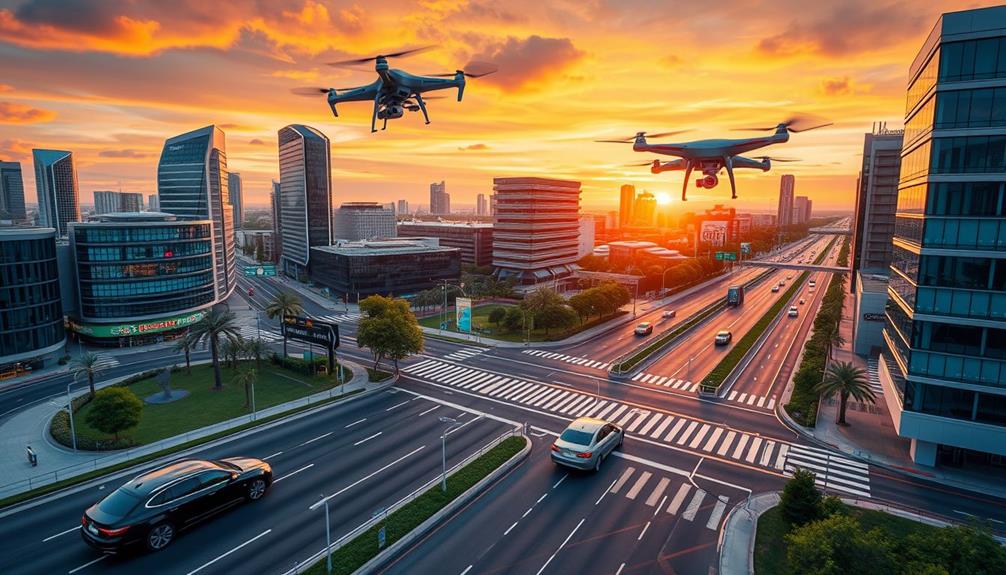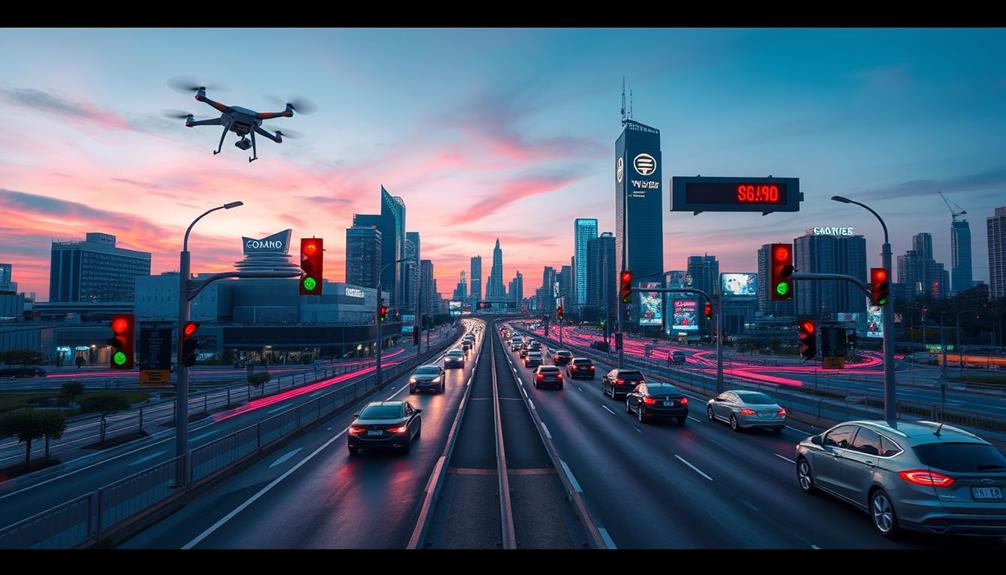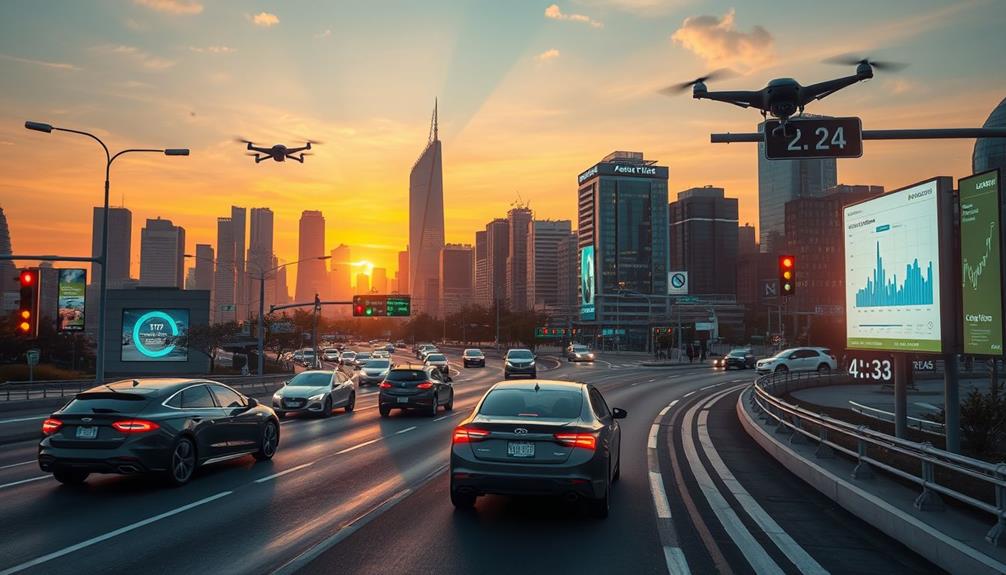AI's revolutionizing transportation, enhancing everything from self-driving cars to smart traffic management. You'll find autonomous vehicles reducing accidents and improving safety, while AI-driven algorithms optimize traffic flow, cutting travel times by up to 25%. Innovations like dynamic traffic signals adjust to real-time conditions, boosting efficiency and lowering emissions. Startups are pushing the envelope with electric, self-driving vehicles and advanced logistics solutions. Plus, predictive maintenance guarantees road safety and lowers costs. As these technologies advance, expect significant shifts in urban mobility. Discover how these innovations are set to reshape your travel experience and the industry at large.
Key Takeaways
- Autonomous vehicles (AVs) are set to revolutionize transportation by enhancing road safety and urban mobility through advanced navigation and machine learning technologies.
- Smart traffic management systems optimize vehicle flow and reduce emissions by using AI algorithms to adjust traffic signals based on real-time conditions.
- Predictive logistics technologies leverage AI for demand forecasting and route optimization, significantly lowering delivery costs and improving efficiency in transportation.
- Innovative startups like Zoox and Einride are driving forward sustainable transportation solutions with purpose-built self-driving vehicles and autonomous electric trucks.
- Dynamic charging infrastructure, including wireless charging systems, enhances electric vehicle operations by reducing range anxiety and minimizing downtime.
AI Technologies Transforming Transportation
AI technologies are reshaping the landscape of transportation in remarkable ways. You're witnessing the rise of autonomous vehicles (AVs), which harness machine learning and advanced sensors to navigate safely. By reducing human error, these vehicles could save up to 585,000 lives between 2035 and 2045, making safety and efficiency a priority.
Moreover, the integration of AI in transportation systems aligns with the growing demand for AI cybersecurity jobs to protect sensitive data and infrastructure from evolving threats.
Additionally, smart traffic management systems analyze real-time data to optimize vehicle flow. This can decrease travel times by up to 25%, easing traffic congestion and cutting greenhouse gas emissions by 10-15%. Imagine a commute where you spend less time stuck in traffic and more time enjoying your day.
In the logistics sector, AI-powered solutions streamline operations, automating processes and enhancing demand forecasting. This results in delivery cost reductions of 10-40%, allowing businesses to operate more efficiently.
Innovations like dynamic charging infrastructure for electric vehicles and AI-driven predictive maintenance are also set to improve operational efficiency and sustainability.
These advancements not only reduce costs but also pave the way for a greener future in transportation. Embracing these technologies means embracing a safer, more efficient, and sustainable world.
Current and Future Use-Cases

As you explore the current and future use-cases of AI in transportation, you'll see how autonomous vehicle advancements are set to revolutionize road safety.
Innovations in energy sources, such as geothermal energy generation, are also paving the way for more sustainable transportation options.
Smart traffic solutions are transforming how we navigate our cities, while predictive logistics technologies are optimizing delivery processes.
Together, these innovations promise to enhance efficiency and create a more sustainable transportation landscape.
Autonomous Vehicle Advancements
With the rapid evolution of autonomous vehicles (AVs), urban transportation is on the brink of a transformative shift. These innovations promise not only increased safety but also enhanced efficiency in urban mobility. AVs, equipped with advanced sensors and AI technology, utilize real-time data for navigation and decision-making, markedly reducing accidents caused by human error. An Intel report projects that AVs could save approximately 585,000 lives between 2035 and 2045.
The future of autonomous vehicles looks bright, with use-cases expanding into ride-sharing services and public transport solutions, seamlessly integrating into smart city infrastructure. By 2030, it's estimated that 15% of new vehicles sold will be fully autonomous, a proof of the rapid adoption of this technology.
| Current Use-Cases | Future Potential |
|---|---|
| Ride-sharing services | Enhanced public transport |
| Delivery services | Improved traffic management |
| Personal transportation | Integration with smart cities |
As these advancements come to life, they'll reshape how we navigate our cities, making roads safer and more efficient for everyone. Embrace this change; it's just around the corner!
Smart Traffic Solutions
The integration of autonomous vehicles into urban environments highlights the need for smart traffic solutions that can adapt to changing conditions. By utilizing AI algorithms, smart traffic management systems analyze real-time data to optimize vehicle flow, potentially reducing travel times by up to 25%.
These systems dynamically adjust traffic signals based on current conditions, which can lead to a decrease in greenhouse gas emissions by 10-15%. This effective use of real-time data not only enhances operational efficiency but also builds trust-building with users through improved urban mobility experiences.
Predictive algorithms play an essential role, forecasting congestion before it occurs and allowing for proactive rerouting of buses and emergency vehicles. This enhances response times and minimizes delays, ensuring that emergency services reach their destinations swiftly.
Furthermore, AI-powered traffic management incorporates data from cameras and sensors to monitor road conditions and detect accidents in real time, automatically alerting emergency services.
Looking to the future, the integration of vehicle communication networks will enable vehicles to share real-time data with traffic management systems. This will further improve safety and efficiency, creating a seamless flow of traffic.
As smart traffic solutions evolve, they'll greatly impact urban mobility, paving the way for smarter, greener cities.
Predictive Logistics Technologies
Increasingly, logistics companies are turning to predictive technologies to streamline their operations and enhance efficiency. By utilizing AI algorithms that analyze real-time data, these companies can considerably improve demand forecasting and dynamic route optimization. This could potentially reduce delivery costs by 10-40%, making your logistics processes more cost-effective.
Additionally, the adoption of nutrition practices can lead to healthier choices in the workplace, promoting overall wellness among employees.
Moreover, predictive maintenance for vehicles plays a vital role in enhancing operational efficiency. By implementing predictive maintenance analytics, you can decrease maintenance costs by 5-10% while increasing equipment availability by 10-20%. This guarantees that your fleet remains reliable and ready to meet demand.
The integration of autonomous delivery vehicles and drones is also set to revolutionize last-mile delivery logistics. These technologies not only streamline processes but also contribute to reducing operational costs.
Additionally, real-time tracking enhances transparency in the supply chain, improving reliability and customer satisfaction.
Looking ahead, the future of predictive logistics appears promising. Leveraging AI for automation in shipping processes and further optimizing supply chain responsiveness will certainly enhance overall efficiency, making logistics operations more resilient and adaptive to changing market demands.
Innovative Startups Impacting the Industry

Innovative startups are reshaping the transportation landscape by introducing groundbreaking solutions that tackle urban mobility challenges and enhance logistics efficiency. Companies like Zoox are pioneering purpose-built self-driving vehicles designed specifically for urban environments, aiming to reduce congestion and improve city mobility.
Meanwhile, Einride focuses on autonomous electric trucks, markedly lowering emissions in freight transport to boost environmental sustainability. Investing in cutting-edge technologies, such as Gold IRA provides a hedge against economic instability, is essential as these advancements unfold.
Embark Trucks is also making strides in self-driving technology, particularly for long-haul trucking, improving efficiency and reducing operational costs in logistics. In the sphere of last-mile delivery, Nuro specializes in small autonomous delivery vehicles that optimize local commerce and enhance consumer convenience.
Furthermore, Skyports is pushing the boundaries of urban air mobility by designing infrastructure for electric vertical takeoff and landing (eVTOL) aircraft, integrating these innovative solutions into existing transportation networks.
These startups aren't just enhancing traffic management but are also laying the groundwork for smarter, more efficient urban mobility systems. As AI and autonomous vehicles evolve, these companies are setting the stage for a future where logistics and transportation are seamless, sustainable, and smarter than ever.
Infrastructure and Charging Solutions

As you explore the future of transportation, consider how dynamic charging infrastructure is changing the game for electric vehicles. This technology allows you to charge while driving, alleviating range anxiety and making electric cars more accessible.
Additionally, the importance of clean air can be complemented by the use of air purifiers in electric vehicles, ensuring a healthier environment for passengers.
Plus, with innovations like 3D-printed transport solutions, the development of necessary facilities is faster and more cost-effective than ever.
Dynamic Charging Infrastructure
With dynamic charging infrastructure, electric vehicles can charge wirelessly while on the move, transforming how we think about transportation. This innovative solution eliminates the need for fixed charging stations, greatly reducing range anxiety for drivers.
By integrating AI in these systems, energy distribution becomes more efficient, paving the way for electric vehicles to serve as primary transport options. Additionally, the incorporation of AI-driven threat intelligence guarantees that the infrastructure is secure and resilient against potential cyber threats.
Dynamic charging allows for continuous charging during transit, which dramatically cuts down on vehicle downtime. Imagine cruising along and recharging your vehicle without having to stop! This capability not only enhances the convenience of using electric vehicles but also promotes sustainability by reducing carbon emissions.
As dynamic charging technologies evolve, they incorporate advancements like 3D-printed structures, enabling rapid development and deployment of charging infrastructure along roadways. This agility supports smart traffic management by guaranteeing that charging facilities are conveniently located where they're needed most, benefiting both drivers and the environment.
Furthermore, with the rise of autonomous vehicles, dynamic charging can seamlessly integrate into their operational framework, creating a smarter, more efficient transportation ecosystem.
Embracing these innovative solutions can lead to a sustainable future for all.
3D-Printed Transport Solutions
Dynamic charging infrastructure sets the stage for the next wave of transportation advancements, particularly through the use of 3D-printed transport solutions. These AI-driven innovations are revolutionizing transportation infrastructure by creating 3D-printed structures that enhance sustainability and reduce costs. With wireless technology, dynamic charging systems allow electric vehicles to charge while in motion, alleviating range anxiety and promoting wider EV adoption.
Here's how 3D-printed transport solutions can impact various aspects of transportation:
| Aspect | Benefit |
|---|---|
| Construction Time | Rapid construction reduces project delays. |
| Cost Efficiency | Lower material and labor costs. |
| Material Waste | Reduces waste by up to 60%. |
| Energy Distribution | AI optimizes energy for charging systems. |
| Safety & Efficiency | Real-time data sharing enhances traffic management. |
Integrating vehicular communication networks within these structures further improves safety and efficiency. As vehicles communicate with smart traffic management systems, you benefit from smoother traffic flow and reduced congestion. Embracing 3D-printed transport solutions is key to a sustainable, efficient future in transportation.
Security and Personalization Enhancements

While enhancing security and personalization in transportation might seem challenging, AI-driven innovations are transforming the way passengers experience travel. You'll find that biometric identification, like facial recognition, greatly boosts passenger security while tailoring personalized travel experiences. These systems guarantee that your identity is verified seamlessly, allowing for a smoother journey.
Additionally, the advances in email and communication security highlight the importance of protecting user information in various sectors, including transportation.
Moreover, AI-powered personalization tools analyze your preferences and behaviors to offer customized navigation suggestions and real-time updates. This means you'll receive information tailored to your needs, making your travel more efficient.
Advanced Driver Assistance Systems (ADAS) utilize real-time monitoring to keep an eye on driving behavior and environmental conditions, enhancing safety for everyone on board.
Blockchain integration further strengthens this landscape by enabling secure and transparent ticketing systems, which not only build trust but also reduce fraud in transactions.
Plus, with AI chatbots providing 24/7 customer service support, you can resolve any inquiries or issues promptly, guaranteeing a hassle-free experience.
Altogether, these innovations create a travel environment focused on security and personalization, making your journeys safer and more enjoyable than ever before.
Safety and Security Improvements

Innovations in AI are greatly enhancing safety and security in transportation. With the rise of autonomous vehicles and advanced driver assistance systems (ADAS), you're experiencing a transformative shift. AI-powered cameras detect dangerous driving behaviors, sending alerts to law enforcement to curb reckless driving. This proactive approach markedly contributes to accident prevention.
Moreover, real-time data from AI systems allows for effective monitoring of road conditions and driver behavior. Predictive maintenance alerts notify you of potential vehicle issues before they escalate, ensuring a safer driving experience.
Here's a summary of key safety improvements:
| AI Innovations | Benefits |
|---|---|
| AI-Powered Cameras | Detect dangerous driving behaviors |
| Advanced Driver Assistance Systems | Monitor road conditions and correct driver behavior |
| Predictive Maintenance | Alerts for potential vehicle issues |
| Real-Time Hazard Detection | Immediate alerts for emergency services |
These advancements in traffic management and hazard detection are essential for enhancing response times during accidents, ultimately saving lives. As you embrace these innovations, your safety on the road is markedly improved.
Proactive Traffic Management Strategies

In recent years, proactive traffic management strategies powered by AI have revolutionized how cities handle congestion and improve travel efficiency. By utilizing real-time data from cameras and sensors, AI-driven traffic management systems optimize traffic flow by dynamically adjusting traffic light timings. This not only reduces traffic congestion but also enhances urban mobility, leading to travel time decreases of up to 25%.
Additionally, cities are exploring innovative designs and amenities in transportation to further enhance the overall travel experience.
Predictive algorithms play a vital role in this process, forecasting potential congestion before it occurs. This allows for proactive rerouting of buses and emergency vehicles, improving their response times and minimizing delays.
Additionally, intelligent traffic management can considerably reduce accident rates by identifying high-risk areas and deploying preventative measures based on predictive analytics.
Moreover, these advanced systems contribute to environmental sustainability. By optimizing traffic flow and reducing idling times at intersections, cities can decrease greenhouse gas emissions by 10-15%.
As you can see, implementing proactive traffic management strategies isn't just about improving travel efficiency; it's a thorough approach to creating safer, greener, and more efficient urban environments.
Predictive Maintenance and Efficiency

Leveraging AI for predictive maintenance is transforming how transportation systems operate. By utilizing AI algorithms to analyze sensor data, you can predict maintenance issues before they escalate. This proactive approach can optimize maintenance schedules and reduce downtime by an estimated 5-10%.
With predictive maintenance, you'll see an increase in equipment availability by 10-20%, greatly enhancing operational efficiency. Additionally, just as high-quality heaters improve energy efficiency in pool maintenance, AI can enhance the efficiency of transportation systems.
Airlines and transit agencies that have implemented these strategies report marked improvements in service reliability, leading to fewer delays and higher customer satisfaction. By identifying early signs of deterioration—like potholes or cracks—you can address repairs in a timely manner, enhancing road safety for everyone.
Moreover, the cost savings from predictive maintenance are substantial. By taking proactive measures to prevent major failures and extend asset lifespans, you guarantee that your transportation systems run smoothly and efficiently.
Ultimately, AI-driven predictive maintenance not only boosts operational efficiency but also contributes to a safer and more reliable transportation environment. Embracing these innovations means you're investing in the future of your transportation infrastructure, paving the way for smarter, more resilient systems.
Future Trends and Challenges

Transportation's future is poised for remarkable transformation as AI technologies continue to evolve. You can expect intelligent traffic management systems to notably improve operational efficiency, potentially reducing travel times by up to 25% and lowering greenhouse gas emissions by 10-15%.
As autonomous vehicles become more prevalent, with projections suggesting that 15% of new cars sold by 2030 will be fully autonomous, urban mobility will shift dramatically.
However, adopting AI in transportation isn't without its challenges. Data security risks must be addressed to protect sensitive information, and regulatory compliance will require constant vigilance to adapt to evolving legal frameworks.
The economic impact of AI-driven logistics will be profound; tools for delivery route optimization could cut delivery costs by 10-40%, but this also raises concerns about job displacement in affected sectors.
Looking ahead, future trends indicate that predictive maintenance won't only enhance equipment availability by 10-20% but also reduce maintenance costs by 5-10%.
As you navigate these changes, balancing innovation with safety and compliance will be essential for harnessing the full potential of AI in transportation.
Frequently Asked Questions
How Can AI Be Used in Traffic Management?
AI can optimize traffic management by analyzing real-time data, predicting congestion, adjusting signal timings, and monitoring driver behaviors. You'll see improved vehicle flow, reduced travel times, and enhanced safety on the roads.
How Can AI Be Used in Self-Driving Cars?
You can use AI in self-driving cars to navigate roads, process real-time data, and make split-second decisions. By reducing human error, these technologies enhance safety and efficiency, greatly transforming your driving experience.
How Can Artificial Intelligence Be Used in Smart Transportation?
Imagine a symphony of vehicles flowing seamlessly; AI orchestrates this harmony. You'll witness smart traffic systems predicting congestion, rerouting cars, and enhancing safety, transforming your daily commute into a smoother, more efficient journey.
How Is AI Used in Smart Cars?
AI's used in smart cars to enhance navigation, analyze driving patterns, and anticipate maintenance needs. It helps you avoid accidents by detecting dangerous behaviors and optimizing routes, making your driving experience safer and more efficient.
Conclusion
As we steer into the future, AI-driven innovations in transportation are like a well-tuned orchestra, harmonizing efficiency and safety. You're witnessing the dawn of self-driving cars and smart traffic management, where roads become fluid rivers of movement. Embracing these advancements, you'll navigate through challenges, transforming your daily commute into a seamless journey. So buckle up, because the ride ahead is not just about reaching your destination—it's about enjoying the exhilarating evolution of transportation itself.











